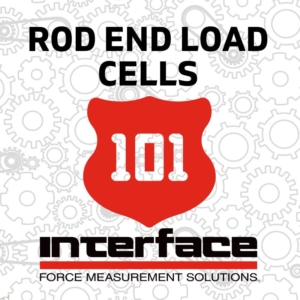Rod End Load Cells 101
 Rod end load cells are designed to measure the tension and compression forces applied to a rod or similar structure. This type of load cell consists of a rod with a threaded connector. The load cell’s strain gage measures the deformation caused by the applied force. As the force is applied to the rod, it deforms slightly, causing a change in the electrical resistance of the strain gage.
Rod end load cells are designed to measure the tension and compression forces applied to a rod or similar structure. This type of load cell consists of a rod with a threaded connector. The load cell’s strain gage measures the deformation caused by the applied force. As the force is applied to the rod, it deforms slightly, causing a change in the electrical resistance of the strain gage.
To provide a complete analysis of the forces being applied to the structure, rod end load cells are often used in pairs, with one load cell measuring tension and the other measuring compression.
Interface Rod End Load Cells utilize proprietary temperature compensated strain gages for high-accuracy measurement. For example, our popular REC Rod End Load Cell is fatigue rated and designed to go up to 100,000,000+ fully reversed cycles which makes them ideal for test article failure tests. Our REC models are resistant to off-axis and impact loading with performance to .04%. They are environmentally sealed and made of stainless steel. They are easy to integrate in actuators.
Rod end load cells are commonly found in test labs and used in industrial environments, mechanical systems, and testing machines. They are adaptable and reliable force measurement devices utilized for applications in various industries.
Common Rod End Load Cell Use Cases
- Material Testing: Rod end load cells are widely used in material testing applications, such as tensile testing, compression testing, and fatigue testing. They help measure the applied forces accurately and provide data for analyzing material properties, structural integrity, and performance.
- Machine Force Monitoring: Rod end load cells are used in industrial machinery to monitor and control forces applied to rods, shafts, or other structural components. They help ensure that the machinery operates within safe load limits, preventing overloading and potential failures.
- Hydraulic and Pneumatic Systems: Rod end load cells are employed in hydraulic and pneumatic systems to measure the tension or compression forces experienced by cylinders, pistons, or actuators. This enables accurate force control and monitoring for proper system use.
- Robotics and Industrial Automation: Rod end load cells are integrated into robotic systems to measure the forces exerted by robotic arms or grippers. This allows for precise force control, feedback, and safety features in tasks such as assembly, material handling, and force-sensitive operations.
- Calibration and Test Lab Equipment: Rod end load cells are utilized in calibration and testing equipment, such as force testers and dynamometers. They provide reliable and traceable force measurements, ensuring the accuracy and calibration of the testing instruments.
- Aerospace and Automotive Industries: Rod end load cells find application in both aerospace and automotive industries for various purposes, including component testing, structural analysis, quality control, and safety testing. There are many use cases to rod end load cells for multiple industries, as found in our application solutions.
- Research and Development: Rod end load cells are used in research and development activities across different fields, enabling precise force measurements for studying material behavior, product development, and prototype testing.
Drone Fireworks Rod End Load Cell Application
Drone fireworks have become increasingly popular in recent years. During drone firework and light shows, drones are equipped with LED lights, flying in synchronized patterns to create displays in the night sky. Four rod end styled Interface WMC Sealed Stainless Steel Miniature Load Cells are installed to the necessary propeller motors measure the attached LED lights. Each are connected to a WTS-AM-1E Wireless Strain Bridge Transmitter Modules. The WMC’s measure the weight of the LED lights to monitor weight shifting or any uneven weight distributions. Data results are wirelessly transmitted through the WTS-BS-4 Wireless Base Station.
Interface offers a wide range of rod end load cells. The following highlights our standard models for this type of load cell. Customization is an option if a rod end load cell is needed to be designed into machines or used as a component within a specific product.
Interface Standard Rod End Load Cells
REC Rod End Load Cell stainless steel mini with capacities from 1K to 50K lbf (5 kN to 220 kN).
WMC Rod End Load Cell industrial grade rod end type has capacities 15K to 200K lbf (65 kN to 900 kN).
WMC Sealed Stainless Steel Miniature Load Cell environmentally sealed in capacities from 5 to 500 lbf (22 to 2200 N). Submersible versions also available.
WMC Sealed High Capacity Stainless Steel Miniature Load Cell ranging from 1K lbf to 10K lbf (5 kN to 45 kN). Submersible versions also available.
WMCP Overload Protected Stainless Steel Miniature Load Cell With Male Threads is an excellent safeguard in rugged applications with capacities 1.1 to 2.2 lbf (500 to 1000 gmf).
WMCFP Overload Protected Sealed Stainless Steel Miniature Load Cell With Female Threads in 1.1 to 2.2 lbf (500 to 1000 gmf) capacities are stainless steel, sealed, and environmentally protected.
WMCF Miniature Sealed Stainless Steel Load Cell is an industrial design with capacities from 5 to 10 lbf with female threads.
MTFS Miniature Tension Force Load Cell is a small sized tension load cell available in capacity ranges from 1 kN to 100 kN (224.8 to 22.5K lbf).
NEW! ITCA Tension And Compression Load Cell is ideal for measuring both tensile and compressive forces 2.2K lbf to 330.6K lbf (1 MT to 150 MT). The standard metric threads at each end of the load cell are designed to accept standard spherical seating rod-end bearings. Customization is available.
Benefits of Interface Rod End Load Cells
#1 High accuracy: Our rod end load cells provide high accuracy in measuring the tension or compression force applied to a rod or similar structure. They are capable of measuring very small changes in force, making them suitable for precise measurement requirements and applications.
#2 Range of measurement and dimensions: Interface rod end load cells are available in a wide range of measurement capacities and compact size making them suitable for use in a variety of industrial and mechanical applications.
#3 Durability: Rod end load cells are designed to withstand harsh environments, high loads, and repetitive use. They are made from ruggedized materials, stainless steel or aluminum, so that can withstand exposure to moisture, dust, and other environmental factors.
#4 Versatility: Rod end load cells can be used in a variety of applications including material testing and manufacturing processes. They can be easily integrated into existing actuation systems and are compatible with a variety of instrumentation and control systems.
Rod end load cells, as highlighted in our recent Testing Lab Essentials Webinar, are used in applications that involve the measurement of tension or compression force on a rod or similar structure, such as in material testing or in the calibration of testing machines.
 Mechanical engineers play a crucial role in the design, development, and maintenance of mechanical systems that are integral to modern society and industries. They apply tenets of physics, materials science, and engineering to design, test and analyze, fabricate, and maintain mechanical systems in various
Mechanical engineers play a crucial role in the design, development, and maintenance of mechanical systems that are integral to modern society and industries. They apply tenets of physics, materials science, and engineering to design, test and analyze, fabricate, and maintain mechanical systems in various 
